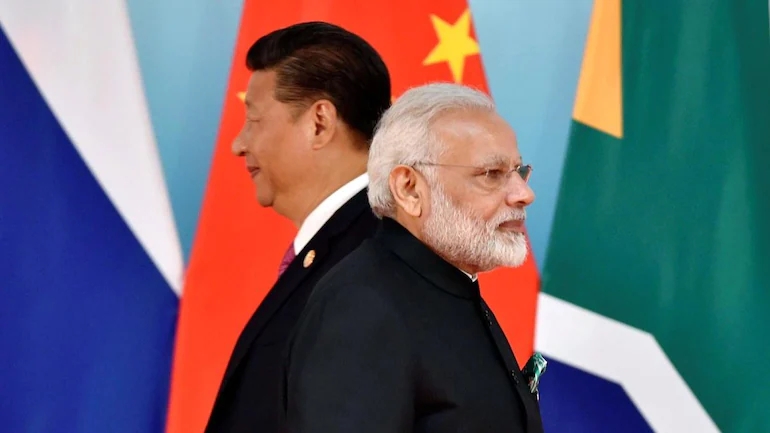
Economic Divergence Unfolds
India has emerged as fastest growing economy with 8.7 per cent surge while China struggled to stay afloat with $ 5.5 trillion package
K.A.Badarinath
It’s a tale in contrast. The two countries have always been viewed as competitors to gain global footprint, acceptability and reach. Presently, the two nations in question are going through a differential economic curve that depicts a picture in contrast.
Without second guess, one would easily make out that it’s the economic story of China and India that are unfolding differently in the backdrop of a huge crisis in Eastern Europe and Baltic region, rise in commodity prices leading to huge inflationary pressures and thereby tightening of money policy by central banks.

The humungous fiscal stimulus package announced by President Xi Jinping’s administration indicates that not everything is going right for China’s economy that’s in complete control of the Communist Party of China, its minions and the oligarchs.
Protracted lockdowns in various cities of China owing to Covid 19 pandemic has pushed the dragon country’s economy into an abyss. While it struggles to stay afloat with positive growth, China has lost its exalted position as the fastest growing country.
President Xi, cabinet, state council and CPC decision to pump prime the economy speaks volumes on the crisis that has rattled the world’s second largest economy. Ukraine war, disruption in its supply chains and resultant slide in manufacturing growth has led to rampant pink slips and loss of livelihoods.
Bloomberg’s back of the envelope calculation put the fiscal stimulus at $ 5.3 trillion that President Xi’s communist administration has announced. From deep tax rebates, cheap loans, withdrawal of restrictions on automobiles buying to booster dose for e-platform companies, China seems to be trying every trick to get back the growth mojo.
Already, Chinese monetary authorities and its central bank seem to have reconciled to the challenge faced in achieving downwardly revised growth of 5.5 per cent in 2022. Investment bank UBS forecast of 4.2 – 3 per cent growth in China has not only unnerved President Xi who’s preparing for third term coronation in September. Earlier this week, J.P.Morgan had also cut the China growth forecast to 3.7 per cent from earlier 4.2 per cent.
There seems to be no easy way out of economic bind in which China has landed itself especially after the Communist regime went on a war path against the growth drivers like the big home grown technology companies and platform enterprises.
David Qu, Bloomberg’s China economist may be right when he says that Chinese central bank has now only played a supportive role. And, the government’s fiscal measures had more space to support growth in the $ 17 trillion Chinese economy.
Implementing the fiscal package may also pose a big problem as there’s reported resistance from states and local governments whose finances are already fragile, borrowings touching the roof and very little elbow room to undertake development projects. Otherwise, there’s no plausible reason for Xi’s administration to send dedicated task forces to 12 provinces to realize the actual economic package.
In contrast, Indian that’s celebrating eight years of BJP government in office is on a virtual high. Prime Minister Modi’s decisive leadership to deliver on economic and development front has worked.
India has emerged as the fastest growing economy globally displacing China with 8.7 per cent GDP uptick in fiscal year ending April 2022. Incidentally, this is the highest growth posted by India in 22 years after 8.8 per cent reported in 2000.
India with its $ 3 trillion economy is making waves globally with new partnerships and markets thereby creating new work opportunities for the aspiring youth. Having navigated the two difficult waves of Covid 19 pandemic relatively unscathed, India’s reading along with its partners like Australia, Japan and US to displace China with alternative and sustainable supply Chains.
If one were to go by chief economic advisor V. Anantha Nageswaran, even in current fiscal, India’s economic growth has been estimated at 7.5 – 8 per cent. At this juncture, these projections may look daunting due to slide reported in January – March 2022 at 4.1 per cent. Economic resilience back home and deft management is what one can bank upon to realize this expansion.
Core sector performance of 8.6 per cent spread over eight infrastructure areas during April 2022 provides enough optimism for maintaining the growth momentum in the Indian context. Given the government’s continued commitment to invest over Rs 750,000 crore across infrastructure areas, India will continue to be the brightest spot in the global growth sweepstakes.
Given the hard work put in by Prime Minister Narendra Modi and his government in last eight years, retaining the tag of fastest growing economy should be celebrated as a big leap forward. This does not mean that Indian leadership should be carried away by the euphoria and not recognize the challenges like crude prices touching $ 120 as against budgeted $ 75 per barrel apart from surge in other commodities prices.
If data available with credible agencies like International Monetary Fund (IMF) and World Bank are anything to go by, then India may be the only large economy that would post GDP growth beyond 7 per cent till 2025.
Creating jobs for millions of unskilled, semi-skilled and low-end earners in rural hinterlands may have to be the focus while Prime Minister Modi’s government goes about methodically in economic integration to evolve India as a unified behemoth.
(Author is Director & Chief Executive of Centre for Integrated and Holistic Studies based in New Delhi.)

